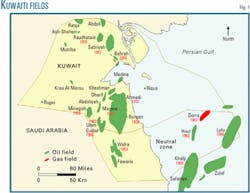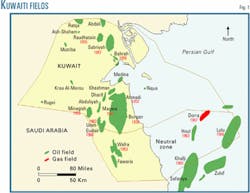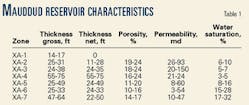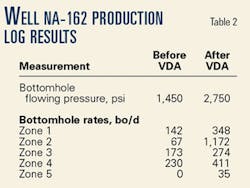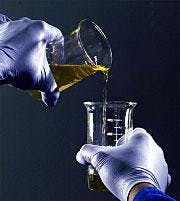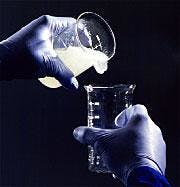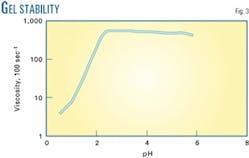Eighteen field trials of a new polymer-free viscoelastic diverting acid (VDA) in Kuwait Oil Co. (KOC) wells restored production and increased reserves from both new and existing wells completed in the Mauddud formation, in the north fields of Kuwait.
VDA is a recent innovation in carbonate reservoir stimulation. This self-diverting fluid system is a viscoelastic surfactant-based acid formulation that stimulates first the highest permeability carbonate zones and then diverts the remaining fluid into the lower permeability or more damaged zones.
As the VDA surfactant system reacts with rock matrix, the viscosity of the treatment fluid builds up and acts as a temporary barrier that, layer by layer, diverts the remaining VDA into the untreated, lower permeability intervals.
By first acidizing the higher permeability zones and then diverting the remaining treatment fluid into the lower permeable zones, the jobs ensure uniform distribution of the treatment fluid across the entire pay zone. It has been well documented that full coverage of the entire pay zone is key to any form of matrix treatment.
The self-diverting nature makes VDA well suited for treating zones with widely varying permeability streaks, thus improving treatment effectiveness in historically challenging carbonate stimulation jobs.
Multicore flow tests in an independent core lab sponsored by an industrial consortium demonstrated excellent self-diverting and stimulation capabilities of VDA. The recent field tests in Kuwait confirmed this effectiveness.
Need for stimulation
The hydrocarbon fields within Kuwait are divided into four zones: north, south, and west fields, and the Neutral Zone (Fig. 1). Most fields have between 7 and 15 different producing reservoirs, and almost all reservoirs are oil bearing.
Reservoir depths range from 500 to 18,000 ft, with average formation permeabilities ranging from 2 md to 10 darcies.
KOC acid stimulates the majority of the carbonate wells prior to putting them on production.
Most Kuwaiti fields were discovered more than 40 years ago and are in a mature state of depletion, requiring secondary and tertiary recovery methods to boost reservoir pressure and increase production. For this reason, KOC recently has constructed seawater-injection plants and currently is completing gas-lift plants, which are further driving the need for stimulation methods to restore and increase production rates and reserves for both new and existing wells.
The Mauddud reservoir in the north fields is heterogeneous in nature, consisting of seven main lithology sections whose permeabilities vary significantly (Table 1). Perforations extend 130-200 ft throughout the sections.
Wells on the structure's flank produce a 22° gravity oil, while wells on the crest produce an average 28° gravity oil.
In 2001, KOC implemented water injection and gas-lift programs because depleting reservoir pressure could not sustain natural hydrocarbon flow.
Stimulation challenge
The use of a polymer-based self-diverting acid (SDA) pumped through coiled tubing has been a well-established practice for stimulating Kuwait's heterogeneous carbonate reservoirs. This also was the case for the Mauddud formation in the north fields.
In the past, during stimulation of the Mauddud carbonates, permeability variations provided the main obstacle in obtaining effective treatments because streaks in the main lithology sections range from 5 to 250 md. More recently, the Mauddud formation has produced mainly through the short strings of dual-completed wells.
The shift from single completions to dual completions, with the long string producing the Burgan sandstone while the short string produces the Mauddud carbonate, presented concerns for KOC regarding the use of coiled tubing in the short string. The coiled tubing possibly could swirl around the long string and become stuck.
Because of this, the operator prohibited the use of coiled tubing in the short strings, which left bullheading as the only option for Mauddud stimulations in dual-completions.
KOC consulted several service companies in its search for an optimal well stimulation solution. After careful consideration, it deemed chemical diversion as best suited to treat the target reservoir effectively because of the heterogeneous formations and completion limitations.
Given the extensive interval length and high-permeability contrast among zones, however, an effective chemical diversion procedure would require an advanced fluid system that had self-diversion and stimulation capabilities.
A demonstration of the VDA system showed its ability to achieve stimulation treatment objectives in the Mauddud carbonate. This convinced KOC to field test VDA technology, an enhanced nonpolmer version of the existing SDA.
Although SDA use had good results in the past, there was still room for improvement. The two diverting acids are similar in that they both form gels in situ when acid spends in a carbonate formation. SDA, however, has a polymer base, and hence solids, thus leaving behind a residue in the formation when broken.
In addition, the polymer-based fluid requires a crosslinker and breaker.
VDA is a non-polymeric system whose basis is a field-proven viscoelastic surfactant, the ClearFRAC technology, which is a clean and nondamaging system used in proppant fracturing. VDA systems are formulated using a newly developed surfactant with as much as 28% HCl mixed in.
When prepared, VDA's initial fluid apparent viscosities, at bottomhole temperature (BHT), are less than 2-3 cp (Fig. 2). The fluid does not require internal crosslinkers because VDA contains no polymers. As a result, less friction is generated during a job. Lower viscosities and friction pressures serve to reduce horsepower requirements during pumping.
Conventionally, the oil industry uses a diversion pad and a reactive fluid in stages to achieve uniform diversion. When being pumped into carbonate formations, VDA is self-diverting and stimulating, meaning that the treatments do not require a separate diversion pad and reactive fluid.
When injected downhole, the VDA fluid first enters the high-permeability zones. The acid in the fluid spent on propagation produces wormholes through carbonate formation rock. Upon the acid contact with the matrix, the VDA system begins to gel and develop its viscosity barrier (Fig. 2, right photo). The gelled system temporarily plugs wormholes, fissures, and the rock matrix, thus forcing the remaining VDA to divert to lower permeability zones or layers.
While conventional polymer based systems start to lose the generated viscosity as the acid becomes totally spent, the VDA gel remains stable, thus maintaining viscosity control longer. This minimizes the possibility of prematurely losing the diverting barrier between the job stages enhancing diversion and achieving full zonal coverage (Fig. 3).
After the job is complete and the production resumes, produced hydrocarbons, diesel, mutual solvents, or produced water effectively breaks the surfactant microstructure and lowers the gel viscosity to near water-like viscosity. Because no polymer or solid particles are in the VDA system, the broken fluid flows back readily from the well, leaving no formation damage.
VDA also can stimulate water-injection wells. These jobs use mutual solvent pre and post-flushes because there are no hydrocarbons to break the VDA gel. Also, in this case, there is no need to flow back the well because the mutual solvent post flush and injected water will completely break the system.
One must, however, flow back the well to remove the polymer and metal crosslinker when using conventional polymer fluids for injection well stimulation.
Because VDA viscosifies in the formation rather than the tubing string, it can be pumped easily through coiled tubing. For carbonate reservoir stimulation, coiled tubing provides an optimum placement technique for acid diversion to broaden interval coverage and enhance stimulation treatment effectiveness.
When stimulating carbonates, the current VDA application temperature limit is 300° F. for acid strengths ranging from 3 to 28% HCl.
The field trials successfully tested VDA in 18 wells having a temperature range from 200° F. to 290° F. BHST.
Initial field test
After careful study, KOC agreed to a trial use of VDA in the Mauddud formation of its north fields. It raised a concern regarding treatment evaluation, however, because the planned jobs in the short string prohibited any subsequent production logging tool (PLT) runs. In addition, while drilling fluids invasion had damaged the candidate wells, the wells were new and had never produced, thus eliminating a basis for direct comparison when evaluating treatment effectiveness.
As a result, KOC decided to treat an existing Mauddud single completion, enabling interpretive results of the VDA job. It selected the NA-162 well as the trial candidate. The well had five sets of perforations, totaling 133 ft, extending throughout the Mauddud layers. The permeability contrast among the five zones varied from 3 to 600 md.
Because the well was a single producer, the treatment could use coiled tubing.
Before the treatment, the PLT density and spinner curves indicated that the bottom set of perforations was not producing. Data also indicated that only some perforations within the upper four zones contributed to total flow.
The post PLT, after the VDA treatment, showed that all perforations throughout the five zones contributed fully to total flow. The oil production for Zones 1 and 2 increased by 245 and 1,749%, respectively (Table 2). The pre and post-stimulation PLT interpretations confirmed that diversion was accomplished. This was important for achieving uniform production and minimal drawdown.
This test demonstrated that VDA helped achieve not only diversion goals but stimulation objectives as well. Comparisons of the pre and post-well test analyses showed a production increase of more than threefold, from 510 to 1,730 bo/d, at the same choke size. After the treatment, the skin improved substantially from about 100 to -3. Additionally, the wellhead pressure (WHP) increased to 651 from 195 psi, while the flowing bottomhole pressure (FBHP) increased to 2,750 from 1,450 psi.
Expanded tests
After the successful results of the NA-162 VDA treatment, KOC expanded the field trial to 17 dual-completed producers. Most of these treatments bullheaded the fluids because KOC had prohibited coiled tubing use in short strings.
One can use VDA by itself as the main acid treatment, pumped as a single reactive fluid that will stimulate and self-divert in one step. Or, one can use it in conjunction with other acid treatment fluids, pumped in several stages as a diverting fluid alternately with an inhibited straight acid or an emulsified acid to enhance the zonal coverage.
For the Mauddud reservoir, the treatments used VDA in conjunction with emulsified acid.
The jobs first pumped VDA to stimulate the higher permeability zones and reduce the permeability contrast among different intervals. Then, emulsified acid was pumped to enhance the simulation of the remaining zones.
All treatments performed beyond KOC's expectations based on the experience of earlier treatments in the same wells or offset wells.
KOC realized a production increase of 14,587 bo/d after stimulating 10 wells in the north fields. This exceeded KOC's expected production increase after stimulating eight development wells by 5,625 bo/d, an average increase of 700 bo/d/well compared to conventional stimulation techniques.
During the field trials, the team gained experience in applying VDA to the Mauddud carbonate formation. Experience showed that VDA followed by specialized emulsified acid gave the optimum results from the standpoint of treatment effectiveness and diversion.
To ensure further VDA success, the team ordered extensive prejob lab tests, including slugging and emulsifying tendencies with formation crude.
Additional jobs
KOC performed additional VDA treatments on wells located on the left flank of the field, which had not produced after being acid treated with other fluid systems.
Well XA-117T-Ma, previously stimulated with SXE and SDA, could not sustain flow after the acid treatment and nitrogen (N2) lift. Later, a VDA acid stimulation of the Mauddud formation resulted in the well producing 732 bo/d of 20° gravity oil through a 32/64-in. choke, with a 190-psi WHP.
As a result of the XA-117 success, KOC also used VDA to stimulate Well XA-105T-Ma, which is on the same flank. This well had been stimulated previously with SXE and SDA.
Three flow attempts during the 10-month period before VDA treatment proved unsuccessful, resulting in some gas with little or no oil. After VDA stimulation, the well produced at about 800 bo/d of 17° gravity oil with a 215-psi WHP. Based on the successes of the XA-117T and XA-105T VDA stimulation treatments, KOC increased the reserves estimate for this flank area.
After successfully treating the flank wells, KOC decided to treat another well, XA-110, with VDA. This well was a dual-completed Mauddud and Upper Burgan producer. The Mauddud, completed in the short string, previously had been stimulated by bullheading emulsified HCl acid. No production, however, resulted from the acid stimulation and N2 kick off.
Before VDA treatment, a fluid preflush cleaned up the perforations and critical matrix, so that the main treatment could be pumped at higher injection rates and with less surface tension. The pre-flush fluid effectively dispersed and removed drilling mud and formation silt from the target interval.
In the next treatment stage, the VDA fluid stimulated the higher permeability intervals and lowered the permeability contrast among different zones. Lastly, an SXE acid was pumped for further stimulation.
Although the XA-110 well had not produced after the initial SDA-SXE stimulation, it tested after the VDA treatment at 1,436 bo/d and 1,754 bo/d rates on 32/64 and 40/64-in. choke sizes, respectively.
Moreover, the XA-110 VDA treatment used coiled tubing with a pipe straightener in the short string of a dual-completed well. This job proved the successful use of coiled tubing in dual completions, therefore raising expectations for future self-diverting VDA stimulation treatments in the area.
The authors
Majdi Al-Mutawa is a petroleum engineer, field development group (north), for Kuwait Oil Co. His expertise lies in well performance analysis and optimization, production enhancement and stimulation, water shut-off, and complex operations associated with dual-completed wells. Al-Mutawa has a BS in petroleum engineering from Kuwait University.
Ealian H. Al-Anzi is the team leader for field developments (Sabiriyah-Bahra) for Kuwait Oil Co. Previously, he held various engineering, operational, and managerial positions within KOC. His expertise includes enhanced oil recovery (steam injection), field development, project design and planning, complex operations, and reservoir management. Al-Anzi has a BS in petroleum engineering from Marietta College.
Mohamed Jemmali is the Kuwait well services technical engineer for Schlumberger. Since joining Schlumberger, he has held various field operation and management positions throughout West and North Africa before moving to the Middle East. Jemmali has a BS in civil engineering from the University of Texas at Austin.
Mathew Samuel is the stimulation business development manager and fluid specialist for the Schlumberger Middle East and Asia (MEA) area. Previously, he held various managerial and technical positions within Schlumberger. His expertise includes technology transfer and fluid development. Samuel has a PhD in chemistry from the University of Pennsylvania.
